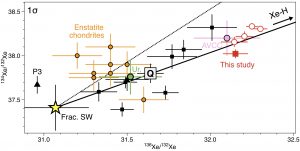Primordial heavy noble gases in the pristine Paris carbonaceous chondrite
D. V. Bekaert, Y. Marrocchi, A. Meshik, L. Remusat & B. Marty
2019. Meteoritics & Planetary Science 54, Issue 2, 395-414
doi: 10.1111/maps.13213
The Paris carbonaceous chondrite represents the most pristine carbonaceous chondrite, providing a unique opportunity to investigate the composition of early solar system materials prior to the onset of significant aqueous alteration. A dual origin (namely from the inner and outer solar system) has been demonstrated for water in the Paris meteorite parent body (Piani et al. 2018). Here, we aim to evaluate the contribution of outer solar system (cometary-like) water ice to the inner solar system water ice using Xe isotopes.
Cometary ice contains abundant Kr and Xe isotopes whose nucleosynthetic signatures are clearly distinct from any known reservoir within the inner solar system (Rubin et al. 2018). During cometary ice melting and subsequent aqueous alteration on the parent body, cometary noble gases may simply be lost to space or trapped within weathering products. Cometary noble gases may also be delivered by potentially isotopically distinct cometary insoluble organic matter (IOM), silicates, and/or presolar grains. We report Ar, Kr and high-precision Xe isotopic measurements within bulk CM 2.9 and CM 2.7 fragments, as well as Ne, Ar, Kr and Xe isotope compositions of the IOM. Noble gas signatures are similar to chondritic phase Q with no evidence for a cometary-like Xe component. Small excesses in the heavy Xe isotopes relative to phase Q within bulk samples are attributed to contributions from presolar materials. CM 2.7 fragments have lower Ar/Xe relative to more pristine CM 2.9 fragments, with no systematic difference in Xe contents. We conclude that Kr and Xe were little affected by aqueous alteration, in agreement with i) minor degrees of alteration and ii) no significant differences in the chemical signature of organic matter in CM 2.7 and CM 2.9 areas (Vinogradoff et al. 2017). Xenon contents in the IOM are larger than any previously published data of Xe in chondritic IOM, in line with the Xe component in the Paris meteorite being pristine and preserved from Xe loss during aqueous alteration/thermal metamorphism.

